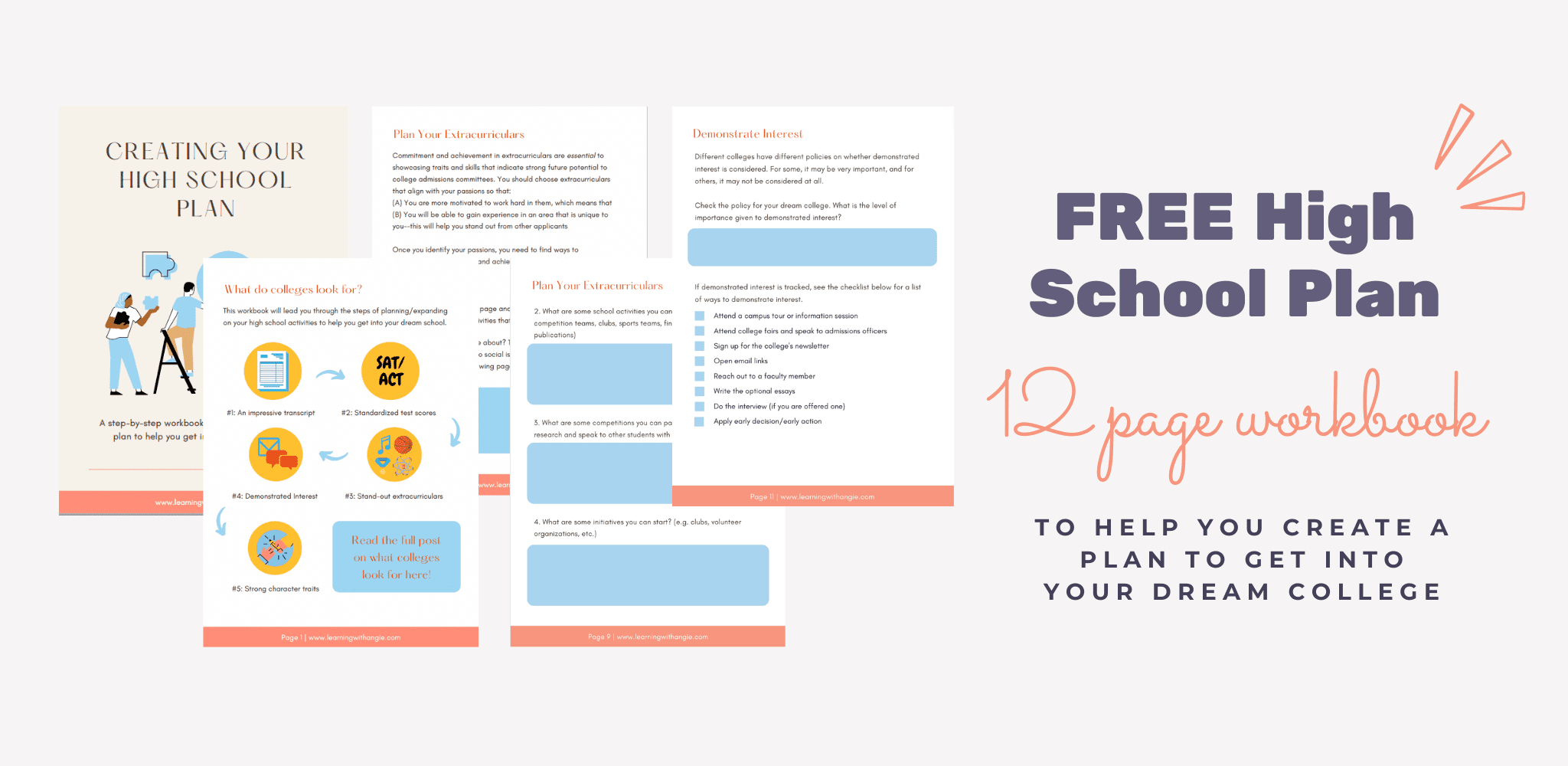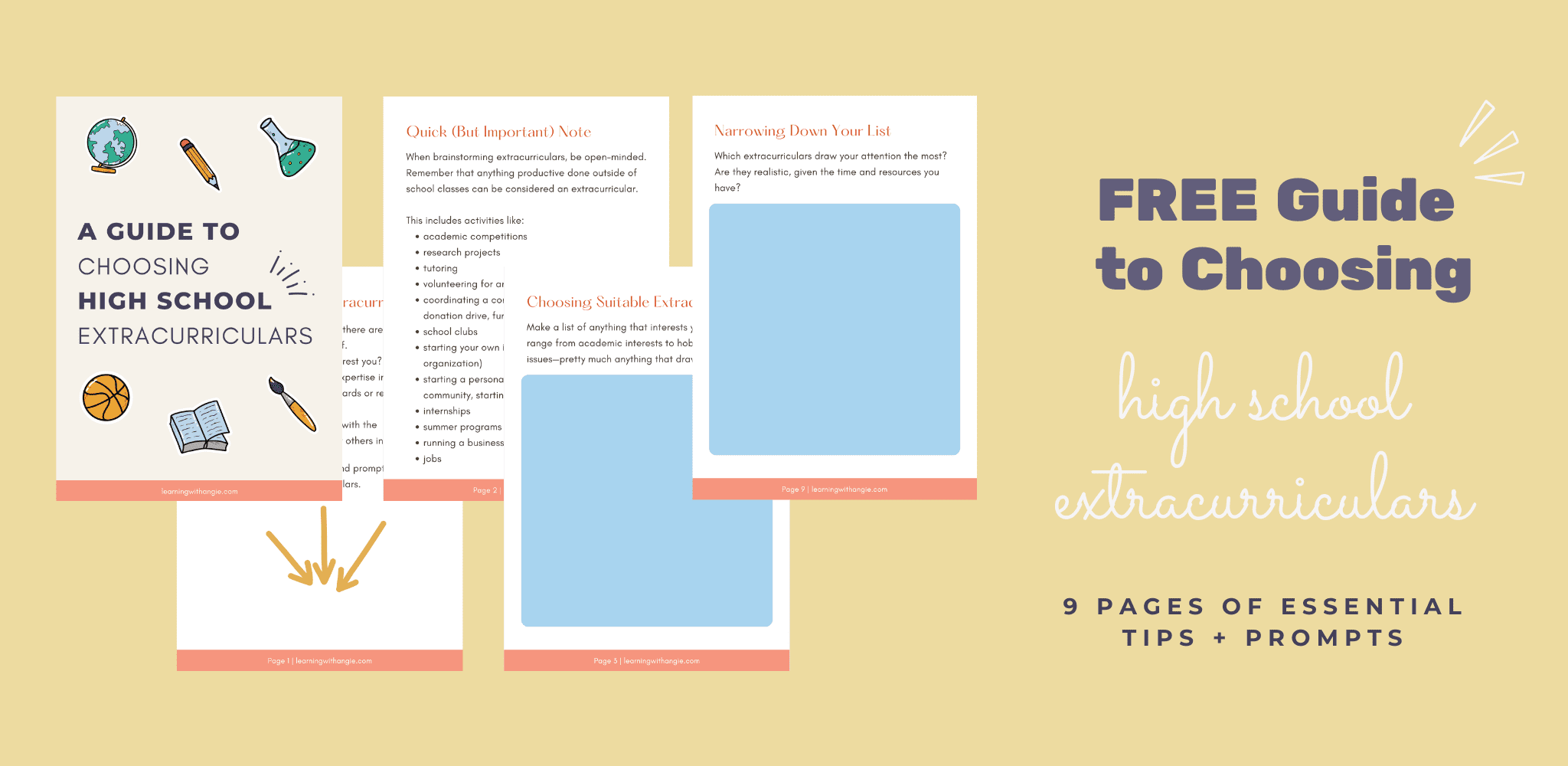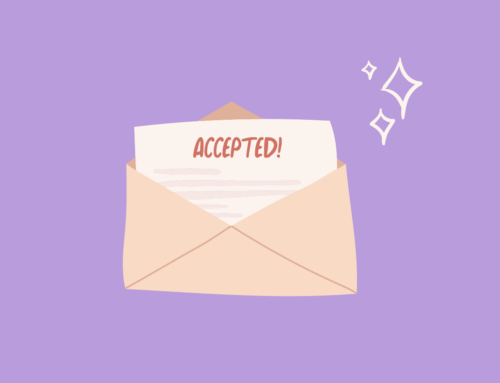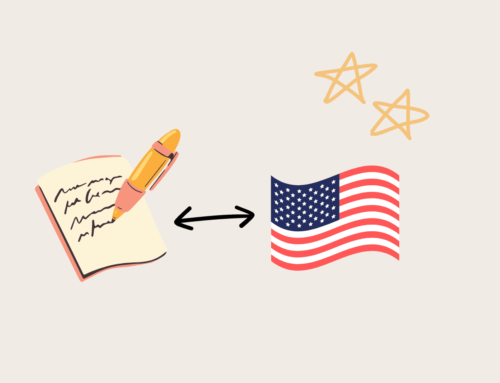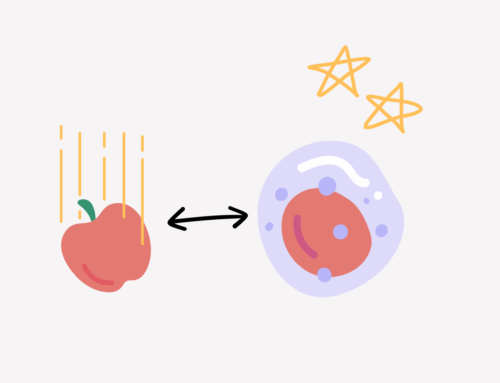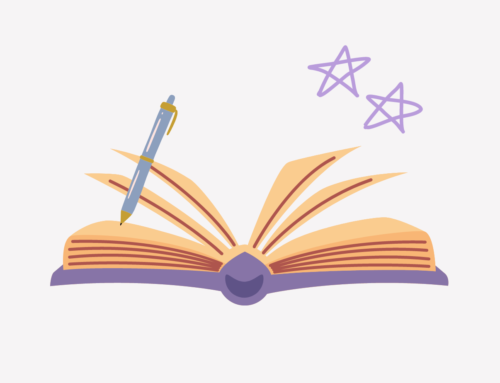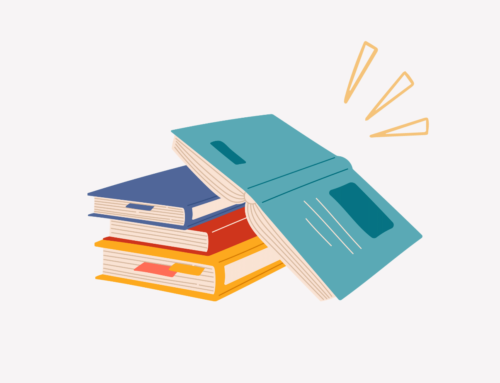
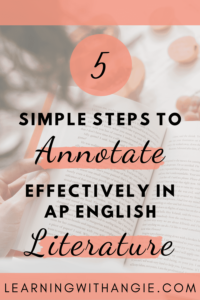
If you’re reading this post, you’re probably taking AP English Literature and Composition this year (if you’re taking AP English Language, check out this guide on how to annotate books for AP English Language instead).
Your summer assignment is to read and annotate a book (or two”¦ or even three, like I did when I took the class) and complete an assignment on it.
Or, the school year has already started and you have a similar assignment, and you’re not sure what to do.
When I first started AP English Literature, I wasn’t sure how to annotate properly either. I had taken AP English Language the previous year, but the two courses were completely different. Therefore, I couldn’t apply the annotation techniques I learned in AP English Language to AP English Literature.
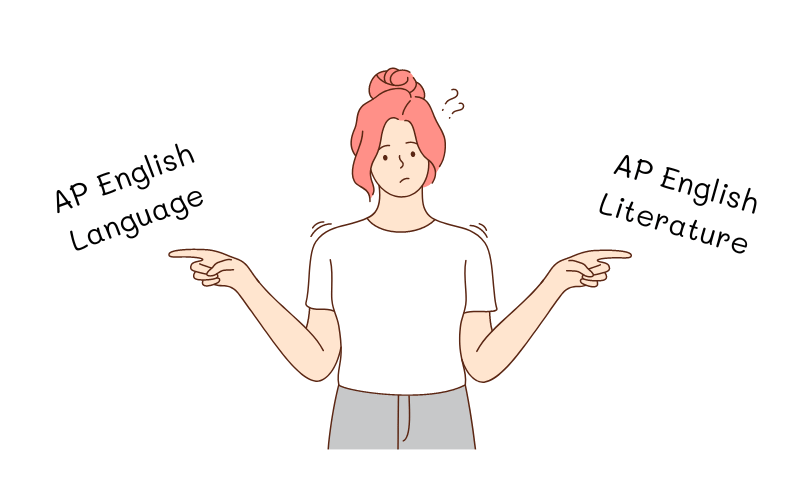
However, over the course of a year, I refined my annotation techniques in AP English Literature. Ultimately, this helped me with critical analysis on the AP exam and led me to score a 5.
In this article, I’ll be providing a step-by-step guide on how to annotate a book for AP English Literature effectively. At the end of it, you’ll also know how to prepare for effective annotation and analysis on the actual AP English Literature exam.
Quick Note: Several sections in this article are identical to sections from the AP English Language annotation guide, if you’ve already read that. However, there are also some important differences that you must take note of.
This post may contain affiliate links, which means that when you make a purchase through a link, I make a small commission at no extra cost to you.
What is the purpose of the AP English Literature course? How is it different from AP English Literature?
AP English Language and AP English Literature are two different courses with two very different aims. When you read and annotate texts for these two courses, you should be looking for and thinking about different things.
Therefore, it’s essential to understand the distinction if you want to do effective annotation.
What Does AP English Language Assess You On?
AP English Language assesses your ability to:
- Identify an author’s attitude toward a subject
- Identify and explain the rhetorical devices the author uses to persuade you of their opinion
- Make your own effective arguments
Let’s take the example of 1984 by George Orwell, a very commonly-used novel in AP English Language classes.
Orwell wrote the book to address totalitarianism. It’s clear from the book that Orwell disapproves of totalitarianism entirely””the whole point of the book is to show how dangerous it is.
In the book, Newspeak is the official language of the totalitarian state of Oceania. It is very limited in what it allows speakers to express, thus controlling their thoughts and ability to resist. Newspeak can be interpreted as a symbol of psychological control and censorship.

Through the use of Newspeak, Orwell illustrates the terrifying control a totalitarian government can exert over people. This is an effective way of conveying his condemning attitude toward totalitarianism.
In AP English Language, you’ll be interpreting many speeches, cartoons, and other forms of media. You’ll be analyzing how authors make their content persuasive. Then, you’ll use what you’ve learned to make your own persuasive arguments.
What does AP English Literature Assess You On?
AP English Literature assesses your ability to:
- Identify the deeper themes in a text (how the text relates to humanity and life)
- Identify and explain literary devices the author uses to convey the themes
Let’s take the example of Frankenstein by Mary Shelley, a commonly-used book in AP English Literature classes.
A primary theme in the novel is the dangers of unrestrained scientific exploration.
Throughout the novel, Shelley uses setting changes to demonstrate how Victor Frankenstein’s scientific ambitions have increasingly isolated him from humanity. Victor goes from living at home to attending boarding school to working in a lab in the mountains to doing a mad goose chase in the Arctic.

As he becomes increasingly engrossed in his scientific work, he becomes increasingly alienated from humanity, both physically and figuratively. The setting of the novel reflects this evolution.
In AP English Literature, you need to read novels and poems and understand their universal themes relating to humanity.
You may also like “Most Impressive AP Classes + Useful Tips to Succeed in Them”
If this still sounds abstract, I highly recommend reading How to Read Literature Like a Professor by Thomas C. Foster. He provides a detailed, easy-to-follow guide for beginners on interpreting the deeper meaning behind literary texts.
After reading his book, I began to see the symbolic and thematic implications in everything I read. Details I would have glossed over previously””a character being drenched in water, a character with certain health issues””took on greater meaning.
What is Annotating?
Before you start annotating a book for AP English, you need to understand what annotating is.
Annotating involves thinking beyond the meaning of the words on the page.
As you read a work of literature, you should be asking questions like:
- Why does the author include this literary device? How does it contribute to characterization or underlying themes?
- What is the context in which the author wrote this work? How might that affect their writing?
- Why does the story take place in this setting? What do setting changes throughout the novel signify?
- What is the significance of this event? Is their symbolic meaning behind the location and characters involved?
- What is the purpose of this recurring motif?
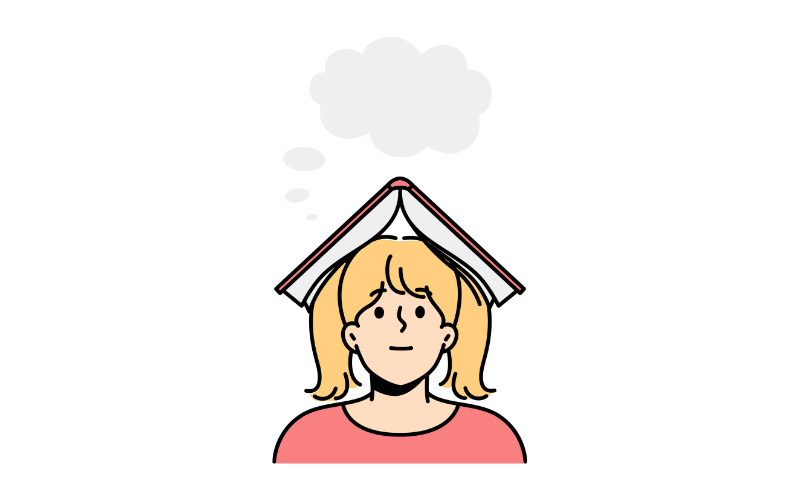
Of course, there are many more questions you can ask. However, I hope these examples give you an idea of what you should be looking for while reading.
Why is Annotating So Important in AP English Literature?
Knowing how to annotate a book for AP English Literature is important because it teaches you to think less literally. As a result, you’ll be able to interpret the deeper meaning of literature, beyond the immediate events of the plot.
After all, the purpose of literature is to provide insight into humanity and life. By developing your annotation skills in AP English Literature, you’ll come to appreciate this.
However, on more practical terms, annotating will also boost your performance on the AP exam.
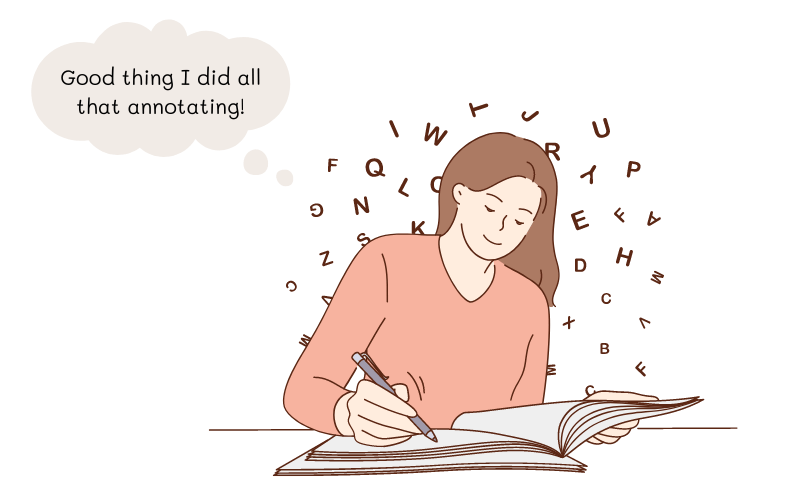
On the AP English Literature exam, you’ll need to analyze several works of literature, poetry and prose alike.
In the multiple-choice section, you’ll be asked questions about the deeper meaning of specific details and the overall passage.
In the FRQ section, you’ll need to write three essays: one poetry analysis, one prose analysis, and one literary argument.
By annotating properly, you develop the critical thinking skills necessary to identify literary devices and explain their deeper meaning on the exam.
What Tools Do You Need to Annotate?
To annotate, you only need a few things that you probably already have:
- A highlighter
- A writing instrument (pencil or pen is fine)
- A copy of the book you’re annotating
- Your brain
- How to Read Literature Like a Professor (optional)
Again, I highly recommend getting a copy of How to Read Literature Like a Professor. If you’re a beginner to advanced literary analysis, Foster does a fantastic job of breaking the topic down in a clear and entertaining way.
Steps to Annotate a Book for AP English Literature Effectively
We’ve finally reached the section on how to annotate a book for AP English Literature. By following the 5 simple steps below, you’ll be on your way to becoming a better AP English student and critical thinker.
You may also like “The Ultimate Guide to Get a 5 on AP U.S. History”
Step #1: Actively Think Beyond the Surface Meaning
The whole point of annotating is to get you to think beyond the surface meaning of the words.
From the moment you pick up your book, you should be questioning the significance of various details. Why did the author include this reference? Why did the author include this character? What is the significance of these lines of dialogue?
Authors include certain details for a reason. Your goal should be to make educated guesses about those reasons.
Also, annotating shouldn’t feel easy because it isn’t easy. As you’re reading and annotating, you should feel the gears of your brain turning.
Step #2: Think About the Overall Themes
AP English Literature is all about recognizing the overall thematic ideas an author is trying to convey. For something to be considered a theme, it must be a central message in the literary work that can be applied universally.
Consider the example of Jane Austen’s Emma. On the surface, the novel is about a self-righteous young woman who loves playing matchmaker but ultimately creates more trouble than good.
On a deeper level, however, the novel reveals an important theme: that self-righteousness can cause great confusion in a harmful way.

Step #3: Identify Literary Devices and Literary Elements
What are Literary Devices?
According to this source, “In literature, any technique used to help the author achieve his or her purpose is called a literary device.”
If you’ve taken AP English Language before, you may be confused about the difference between literary and rhetorical devices. The distinction between the two is somewhat hazy, but this source goes on to elaborate that, “… rhetorical devices can occur in any kind of speech or writing. So all literary devices are rhetorical devices, but not all rhetorical devices are literary devices.”
From my personal experience, there is a lot of overlap. However, it’s not the device itself that matters. It’s how you explain what the device is used for.
In AP English Language, the focus is on the argument the author is trying to make and the devices they use to persuade their audience of that argument. In contrast, the focus in AP English Literature is on the universal themes of the work.

What are Literary Elements?
Unlike literary devices, literary elements apply to large sections or even the entirety of the work.
Common Literary Elements to Look For
In this section, I’ll be covering some of the literary elements I most frequently used in AP English Literature.
As a quick note, all of the examples I use are from Langston Hughes’s short story Early Autumn. The less than 500-word story is about two ex-lovers who accidentally meet again years later.
Literary Element #1: Theme
While Bill has moved on from the relationship, Mary clearly has not. One of the themes evident in the short story is that time and distance can cause tight-knit relationships to drift apart.
Literary Element #2: Mood
The mood is the emotional response that an author is trying to evoke.
In Early Autumn, the mood is regretful and melancholic. Hughes evokes this mood to show how unsalvageable Bill and Mary’s relationship is, despite once spending many nights “walking, talking together”.
Literary Element #3: Tone
Mood and tone are often confused. However, the important distinction is that tone is the author’s attitude toward a subject.
In Early Autumn, Hughes uses short, concise sentences that convey his solemn attitude towards the subject of relationships drifting apart.
Literary Element #4: Setting
Setting is the time and place in which the events of a literary work take place.
In Early Autumn, the setting of autumn is significant. As Foster explains in How to Read Literature Like a Professor, autumn represents aging and endings. In Early Autumn, the season indicates an ending””that of Bill and Mary’s relationship.
Additionally, their encounter takes place in a crowded square of New York City. Most people you pass by in NYC are strangers that you’ll never see again. Hughes intentionally selects this setting to show how Bill and Mary have become strangers to one another.
Common Literary Devices to Look For
In this section, I’ll be covering some of the literary devices I most frequently used in AP English Literature.
Literary Device #1: Metaphor
A metaphor compares two objects to one another directly, without using “like” or “as”.
In the poem Mother to Son by Langston Hughes, he repeats the following metaphor of a crystal stair:
“Life for me ain’t been no crystal stair.”
He evokes a direct comparison between a crystal staircase and life. Through the constant repetition of this metaphor, he emphasizes the theme that we must face many hardships in life. Life is not perfectly smooth and shining like a “crystal stair” would be.

Literary Device #2: Imagery
Imagery is an appeal to the five senses. In the same poem by Hughes, he uses imagery:
“It’s had tacks in it, / And splinters, / And boards torn up, / And places with no carpet in the floor”” / Bare.”
Through the imagery of a staircase marred by blemishes, both small and large, Hughes shows that we must face many challenges in life, both small and large.
You may also like “How to Take APUSH Notes””Improve Speed, Memory, and Grades”
Literary Device #3: Point of View
The point of view is the perspective from which a literary work is told.
Mother to Son is narrated by the mother. She is speaking to her son in a colloquial way, advising him about life based on her own experiences.
In this way, the reader becomes the son in the mother-son dynamic created by Hughes. The reader feels comfortable and open to the wisdom of an older individual. This helps readers embrace the theme that life is filled with hardships but that one must endure them with courage.
Literary Device #4: Symbolism
Symbolism refers to the use of a symbol””an object, an action, a character, or a concept””that represents something else.
In the short story, The Story of an Hour by Kate Chopin, Mrs. Mallard has a mixed response to news of her husband’s death. She weeps and mourns over the thought of his death, yet simultaneously rejoices in her newfound freedom.

It is stated in the first line that she suffers from “heart trouble,” and in the end, she dies from heart disease. In the story, her literal heart problems symbolize her figurative “heart” problems, or conflicting relationship with her husband.
This use of symbolism contributes to one of the overall themes of the story: that women’s inferior status to men in the 19th century often created a complicated relationship between husband and wife.
Literary Device #5: Simile
A simile compares two objects using “like” or “as”.
In the same story by Kate Chopin, she uses a simile:
“”¦ she [Mrs. Mallard] carried herself unwittingly like a goddess of Victory.”
Her comparison between Mrs. Mallard’s response to being liberated and being a goddess of victory highlights the extent of Mrs. Mallard’s joy.
This, in turn, emphasizes the extent to which Mrs. Mallard felt oppressed by her husband, and on a universal scale, the extent to which most 19th-century women were oppressed by their husbands.
Click here for a more comprehensive list of literary devices with examples.
Step #4: Comment on the Significance of the Literary Device
Once you’ve identified the device, you need to comment on its significance. If you don’t, there’s no point in annotating.
Simply identifying examples of figurative language or other literary devices doesn’t reveal anything about the literature’s deeper meaning.
Notice that in the examples I provided in the previous step, I linked the device back to an overall theme.
While annotating, you should be thinking along these lines as well. When you notice literary devices, ask yourself, “How does this detail contribute to characterization or themes in the work?”
As you’re reading, be thinking about the literary elements.
- What is the author’s tone? How does it change throughout the novel?
- What mood does the author try to evoke, and how does it change as the novel progresses?
- What themes do you see unfolding?
- How do changes in the setting contribute to the interpretation of the work?
Always think beyond the surface meaning of the words on the page.
Step #5: Don’t Be Afraid to Mark Other Things
Although it’s important to mark rhetorical devices while reading, you can also mark anything else that warrants a comment.
Not every annotation needs to be incredibly deep and meaningful.
As you’re reading, jot down questions you have or other comments, like an emotional response or a connection to something you’re familiar with.
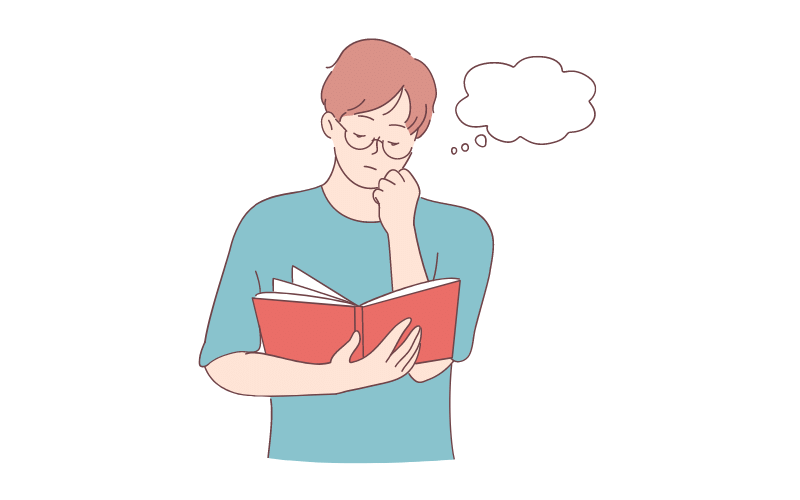
FAQ About Annotating
How Much Should You Annotate?
A common question I see asked is how much to annotate.
In general, I suggest writing as much as possible. Whenever some deeper meaning emerges to you, immediately jot it down.
Also, I recommend going back and rereading. Each time you reread, you will notice new details worth noting down.
However, keep in mind that more does not always mean more. Annotating more does not always equal more value.
Make sure your annotations are meaningful””most of them should probe beyond the surface meaning of the words on the page. They should relate to the message and rhetorical choices of the author.
How Do You Annotate Without Ruining the Book?
Another question I see frequently is how to annotate a book without ruining it.

Ahhh but it’s so beautiful! It would be a crime to write in this
As a book lover who likes to keep my books pristine, I can empathize with this dilemma. In general, however, I am mostly particular about books that hold special memories.
When it comes to non-fiction books and assigned readings, I actually prefer to annotate extensively. Sometimes, I jot down my thoughts directly in the margins. Other times, I highlight a few sentences and write down my thoughts on a sticky note.
However, if you are still worried, check out these options for annotating without writing in the book.
Overview of How to Annotate a Book for AP English Literature
To annotate a book in AP English Literature effectively, you should always be thinking about:
- The universal themes
- Literary choices (literary elements and devices) made by the author to convey the themes
To do this, you should be:
- Actively thinking beyond the surface meaning of the words
- Contemplating the overall themes of the work
- Identifying literary choices
- Explaining the significance of the literary choices
- Asking questions and marking anything else worth bring attention to
Additionally, it’s good practice to reread because with each reread, you will notice new important details.
For help with advanced literary analysis, I highly suggest getting a copy of How to Read Literature Like a Professor. Whether you’re a beginner or have experience with in-depth literary analysis, Foster provides profound insight into the significance of literary choices you would otherwise gloss over.
Throughout the year, I frequently found myself referring back to ideas from this book. It helped me annotate books for AP English Literature in a meaningful way, thus boosting my performance on multiple choice and essay assessments.
Annotating effectively isn’t an easy skill, but it is a valuable one. When you feel discouraged, remember that annotating should feel like it’s really working your brain.
If you feel the gears of your brain turning, remember that you’re strengthening your critical thinking skills. These critical analysis skills will be essential for your success on the AP English Literature and Composition exam and beyond.
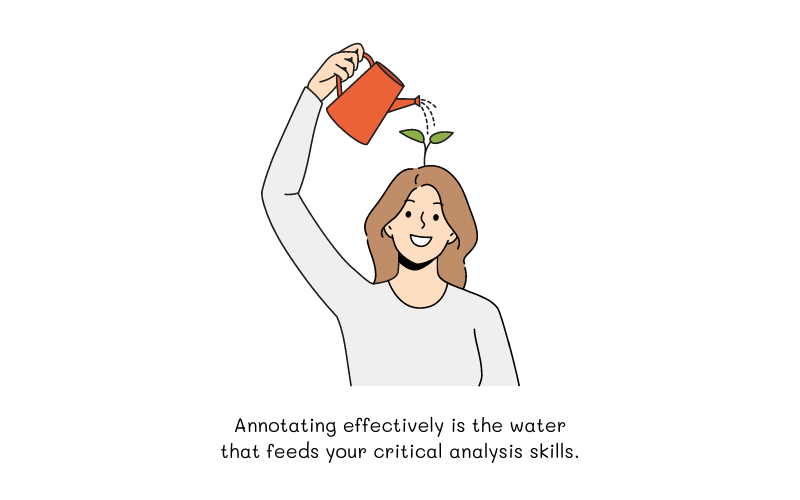
I hope you found this guide to annotating books in AP English Literature helpful! Let me know which book you’re currently reading for AP English Literature in the comments below!
For more posts on AP class tips, check out:
- How to Annotate a Book for AP English Language
- Most Impressive AP Classes (+ Useful Tips to Succeed in Them) Part 1“”math and science
- Most Impressive AP Classes (+ Useful Tips to Succeed in Them) Part 2“”humanities/social sciences and foreign language
- The Ultimate Guide to Get a 5 on AP Spanish Language and Culture
- The Ultimate Guide to Get a 5 on AP U.S. History

Learning With Angie is a place to share honest, unfiltered advice to promote student success. So if you’re a student (high school, college, or beyond) looking for tips on productivity, studying, personal growth, and more to reach your potential, this is the place! To read more about Learning with Angie, click here.

